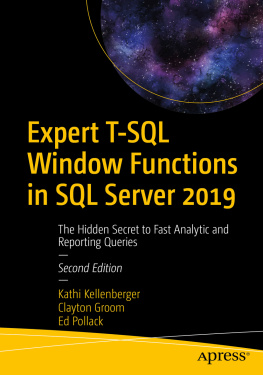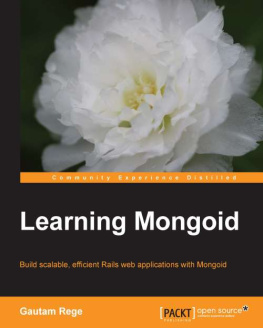SQL
Build Complex SQL Queries
Copyright 2021 - All rights reserved.
The contents of this book may not be reproduced, duplicated or transmitted without direct written permission from the author.
Under no circumstances will any legal responsibility or blame be held against the publisher for any reparation, damages, or monetary loss due to the information herein, either directly or indirectly.
Legal Notice:
This book is copyright protected. This is only for personal use. You cannot amend, distribute, sell, use, quote or paraphrase any part or the content within this book without the consent of the author.
Disclaimer Notice:
Please note the information contained within this document is for educational and entertainment purposes only. Every attempt has been made to provide accurate, up to date and reliable complete information. No warranties of any kind are expressed or implied. Readers acknowledge that the author is not engaging in the rendering of legal, financial, medical or professional advice. The content of this book has been derived from various sources. Please consult a licensed professional before attempting any techniques outlined in this book.
By reading this document, the reader agrees that under no circumstances is the author responsible for any losses, direct or indirect, which are incurred as a result of the use of information contained within this document, including, but not limited to, errors, omissions, or inaccuracies.
Table of Contents
Introduction
Over the last few years, a lot of data has been collected and continues to flow in huge amounts every day. One of the most important things for a business is analyzing and viewing the data correctly to gain insights and get the right outputs. It is also important to ensure you use the data correctly to make the right decisions. Numerous programming languages have been developed which can be used to analyze this information. Some examples are C, which is a popular server development and operating system for embedded systems. If you want to use the databases correctly, you need to use languages developed to assess the information in the database. One such language is the Structured Query Language (SQL), first introduced in the 1970s.
SQL is a language that can be used to create, generate, manage and manipulate data in relational databases. Businesses often prefer the use of relational databases that can store hundreds and thousands of rows of data, but this can only happen when the database is well designed. SQL is the only database language that can be used to manage large databases. Therefore, it makes sense to learn how to work with and manage data with SQL.
Throughout this book, you will gather information about SQL and the importance of learning the language. You will also learn some basic commands used in SQL and explains how you should use the relevant commands to manipulate and use the necessary information in the databases and tables. This book has the necessary information about different types of operators, data types, queries and functions that can be used to work with the data and analyze the information to obtain the relevant outputs. This book also has many examples you can use for practice and some exercises that will help you practice these concepts and understand them better.
Continue to use the information in the book and practice the examples to master SQL. It is also important to know which code you should use and when to use it to obtain the relevant information. Only when you practice will you know where you should apply a specific operator or function.
Thank you for purchasing the book. I hope you get the information you need to master SQL.
Chapter One: Introduction to SQL
You can choose from multiple options when it comes to learning new programming languages, some of which can be used to build your website. You can also use the website to reach your customers in a way that makes it easier for you to convert any potential customers into confirmed customers. Other languages allow you to develop applications and games for your phone. Some programming languages are slightly advanced, which makes them harder to use if you are an amateur.
Most companies use the Database Management System (DBMS) to hold the relevant information that the company can use. This information also includes details and their products and services, and customers. DBMS was one of the first options that came onto the market, making it easier to work with the data. Since the first version of SQL came out, many iterations were developed to help businesses. The latest versions hold on to their information without any difficulty. The simplest DBMS systems designed now are more secure than those developed a few years ago.
Every company needs to hold enough information about:
The company
Employees
Customers
Products and services, and more.
It is important to manage this information safely and securely. To do this, the database needs to be secure. There should also be a way for people to connect the information to analyze the data. It was then that the relational database management system was developed, a more secure database that uses technology to ensure that the information is safe.
If you are a business owner, you need to look at your options and choose the right tools to manage the database. SQL is the perfect tool for this purpose since it is well designed and easy to use. This language was designed to manage data in databases and data warehouses. It also has the necessary tools and functions which can help you keep the data secure. This book will look at what SQL is and how you can use it to protect data.
What Is SQL?
SQL or Structured Query Language is a programming language that is easy to learn and use. It enables users to interact with different types of data and tables in the data warehouses or databases. These tables are always on the same system. SQL was developed in the 1970s, but it gained popularity after IBM built a prototype like SQL and launched it. Most businesses started using this model to analyze their businesses and make some judgments about their business. Oracle was the language that IBM developed, and many businesses are still using this tool all over the world. Both SQL and Oracle are used by businesses to keep the information secure. It is also important to determine if the data is available for the database owner to use. These languages make it easier for one to perform analysis because of the many tools that they provide the user with.
How Does It Work with Databases?
If you choose to work with an SQL database, you will also look at the relevant groups of information while you look at the database. Some people consider these to be the organizational mechanisms that store information that your user can get ahold of later on, efficiently and effectively. You can do this while helping businesses obtain the right information without dealing with bugs and errors.
Relational Databases
Most businesses use relational databases since it allows them to separate the data into various data types and logical units. These tables are interconnected in the database, allowing you to make sense of the data depending on the type of information you require. It is a good tool to use based on the information you need. Use the database to take the complex information and break it down into smaller pieces of information. This will make it easier to manage and optimize the data depending on how you need it.




